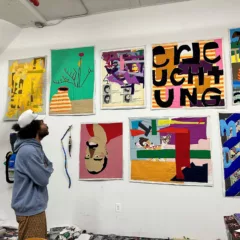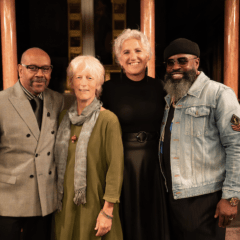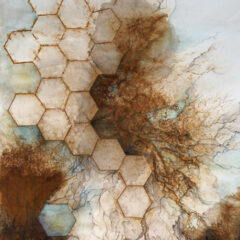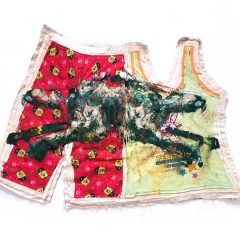[Jennifer speaks with the curator of an exhibit focusing on social justice-related artwork here in Philadelphia, and gives an overview of the impactful works included in the show. — the Artblog editors]
Social justice is a term that can be variously defined, especially in art. Art historian and curator Emily Hage offers intriguing ways to understand what this term means in the exhibition LOOK! Contemporary Art and Social Justice in Philadelphia, on view at St. Joseph’s University Gallery through March 28. This exhibition includes paintings, sculptures, and photographs by four artists who are committed to social change, and whose work “comes from a place of action,” as Hage noted in a phone conversation. Indeed, this exhibition asks the viewer to look at struggles and stories from Philadelphia that may otherwise be ignored or silenced.
Picturing the disenfranchised
The show begins with images of “Trestletown,” by Sarah McEneaney. These works set the stage for this exhibition, which is all about Philadelphia artists making work about Philadelphia’s people, places, and problems.
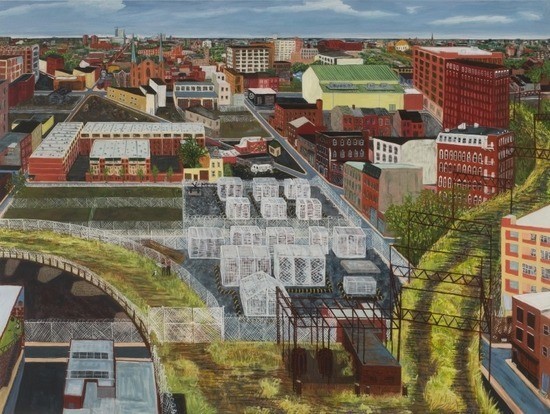
In Susan Hagen’s drawings and sculptures of “Citizens (People of Philly)”, we see everyone from skateboarders, to mothers holding children, to a homeless person sleeping on a city park bench. These small, wood sculptures contain high levels of detail, and they require time and close attention; how different this process is from the way that we pass by homeless people without stopping to notice them. The catalogue essay tells us that art-making for Hagen becomes a deep interchange with her sitters. Her citizens are “participants” in the artist’s process of interviewing, sketching, and photographing.
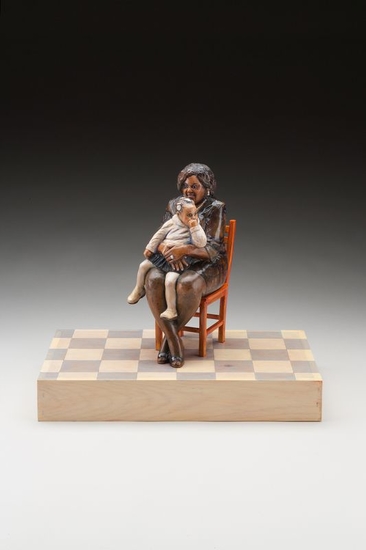
Inspired by the labor-intensive carvings of a 15th-century wood sculptor, Hagen brings to her work all the rich history of this often religious carving tradition. A sculpture of mother and child, 2013’s “Citizens: Likeysha and Ayanna,” in particular carries Christian “Madonna and Child” associations, elevating a typical genre scene into something reverent.
Telling the stories of the incarcerated
Daniel Heyman’s gouache paintings also suggest active participation from his sitters. And, like Hagen’s carefully crafted sculptures, these paintings require active engagement from the viewer. The four portraits here were made when Heyman visited incarcerated men at the National Comprehensive Center for Fathers in Philadelphia. Similar to his celebrated and important paintings of Iraqis imprisoned in Abu Ghraib, Heyman here reveals stories and lives we would otherwise never know. This alone is a corrective justice. Or, as Heyman says in the exhibition catalogue, “We know the stories about black men in Philadelphia, right? But we’ve never heard it from black men in Philadelphia.” These four paintings rectify this dilemma.
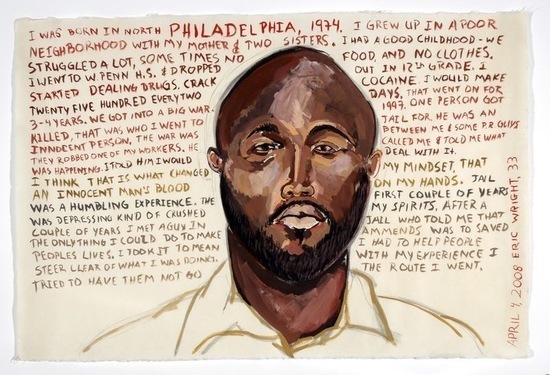
gouache on paper. Courtesy of the artist and Cade Tompkins Projects.
Each work contains a large portrait combined with the text of the sitter’s personal story, often detailing the events that led to the man’s incarceration. This painted text changes colors or swirls around the sitters’ heads in loops; we have to follow it closely with our eyes or trace it in the air with our fingers as it moves vertically, horizontally, or in spirals. The layering and texture of the gouache in the portraits also varies: thick to thin, highly textured to sketchy lines, fully painted in, or not. These formal qualities are visually striking, but what’s more, these techniques keep us actively looking and reading; they ensure that we work hard to get to know these men in their own words. Heyman gives vision and voice to the unseen and the silenced, and paints in a way that demands our full attention.
Putting a face on murder statistics
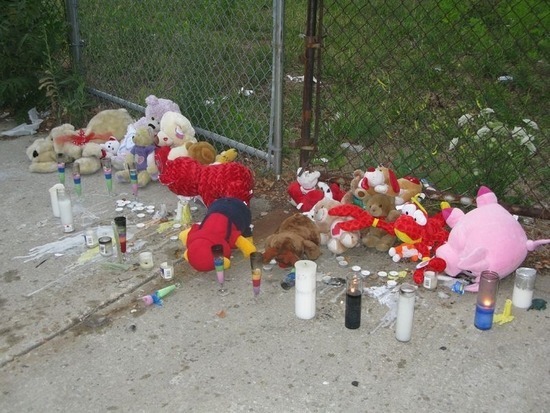
Similarly, Glenn Sacks’ work highlights stories and statistics that may be unknown to many people. He photographs vernacular street memorials made in Philadelphia’s neighborhoods. Heyman’s paintings and Sacks’ images work together in this show in interesting ways, for many of the incarcerated fathers discuss killings and violence; Sacks shows us another outcome of this violence.
The street memorials make real and human what, to some, may be just another statistic in Philadelphia’s yearly murder rate. Hage notes, “Memorials and statistics are a wake-up call. Visual art can present things and put things out there in a way that might make people think about those numbers in a different way.” Sacks’ 15’ x 9’ print titled “Naming the Numbers,” 2012-2013, reinforces this concept. The work includes the date, name, age, race, gender, cause of death, and weapon used for each person killed in the city in the year 1988, the first year that the city made such records public. This print takes up the entirety of a very large wall, and to read and view it requires walking the length of the wall, or straining upward to read the names at the top. This work literally overwhelms, and in a very physical way, it illustrates how immense the problem of deadly violence is in our city.
The catalogue for LOOK!, written by Hage, is an excellent reference about social justice in art in general and about Philadelphia’s many artists and projects focusing on justice issues. Hage will moderate a panel discussion on these topics on March 20, from 5:00 – 7:00pm, at St. Joseph’s Cardinal Foley Campus Center. Susan Hagen, Daniel Heyman, Sarah McEneaney, and Glen Sacks will be in attendance, along with Scott Charles, MAPP, the Trauma Outreach Coordinator for Temple University Hospital and director of the Cradle to Grave Program, an award-winning violence prevention initiative showing the harsh realities of gun violence to public school students and adjudicated youth; and Anthony Williams, teacher at the Philadelphia Juvenile Justice Services Center School Program, which provides students in the juvenile justice system with a unique education approach, giving them the tools necessary to become lifelong learners.
LOOK! Contemporary Art and Social Justice in Philadelphia is on view at St. Joseph’s University Gallery through March 28.


